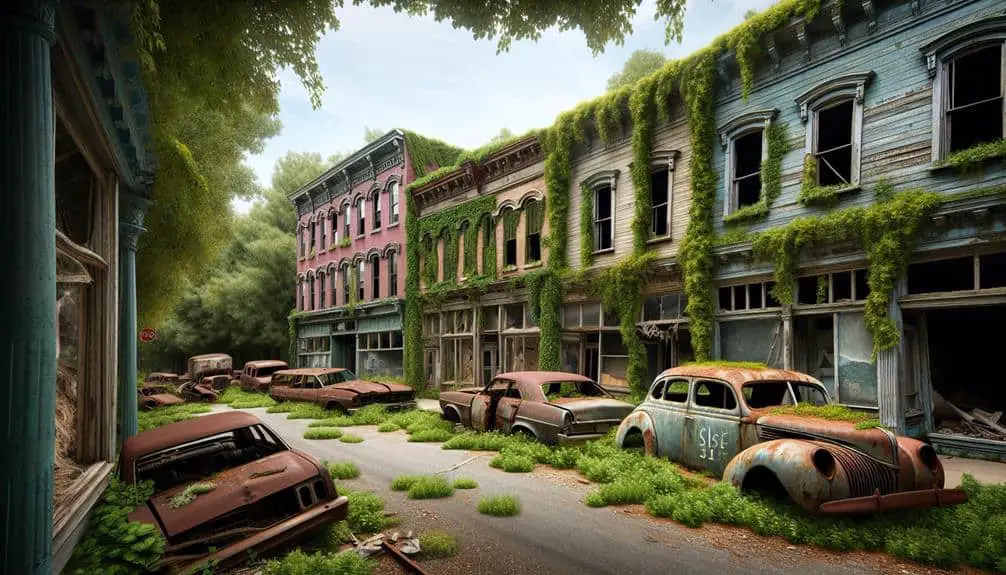When preserving artifacts from post-apocalyptic ghost towns, meticulously document location, condition, and historical significance of mining equipment. Take detailed photos, assess history, and note decay for restoration. For vintage homestead relics, document origins, craftsmanship, and structural integrity. Protect from elements and prioritize restoration needs. Thoroughly record cemetery markers, catalog names, inscriptions, and create digital database for preservation. Assess rusting railroad remnants for corrosion, stabilize with inhibitors, and apply protective coatings. Explore decaying industrial machinery, recognize decay, and preserve through detailed records and photography. Strategic preservation techniques are essential for safeguarding these ghost town artifacts.
Key Points
- Document location, condition, and historical significance of artifacts.
- Assess decay, missing parts, and restoration needs for preservation efforts.
- Research and record the historical background and contribution to the ghost town.
- Collaborate with local historians or descendants for valuable insights.
- Create digital databases for long-lasting preservation of artifacts.
Abandoned Mining Equipment
When identifying abandoned mining equipment in ghost towns, meticulously document their location, condition, and historical significance for preservation efforts. Old machinery and mining tools found in these deserted locations hold invaluable historical importance. To guarantee their preservation, it's vital to catalog each item with precision.
Begin by recording the exact location of the old machinery within the ghost town. Note the specific building or area where each piece is located. Take detailed photographs from various angles to capture the condition of the equipment accurately. Document any visible damage or deterioration.
Next, assess the significance of the mining tools. Research their historical background and explore how they contributed to the mining operations in the area. Understanding the role these tools played will help in determining their importance for preservation.
Lastly, consider the overall condition of the equipment. Note any rust, decay, or missing parts. This detailed documentation will guide restoration efforts and make sure these relics are safeguarded for future generations.
Vintage Homestead Relics
To effectively preserve vintage homestead relics found in ghost towns, meticulously document their origins, condition, and historical significance to guarantee their cultural value endures. Antique tools play a significant role in telling the story of early settlers' lives. When encountering these tools, note their craftsmanship, material, and any markings that could reveal their manufacturer or era. Carefully photograph and catalog each piece, noting any damage or unique features.
Weathered furniture, such as rocking chairs or wooden chests, offer insights into the daily lives of homesteaders. Record the type of wood used, construction techniques, and any decorative elements present. Assess the furniture's structural integrity and determine if restoration is necessary to prevent further deterioration. Prioritize protecting these relics from exposure to the elements, pests, and vandalism.
Haunting Town Cemetery Markers
Preserve the haunting town cemetery markers by thoroughly documenting their origins, inscriptions, and historical significance to secure their cultural legacy endures. Eerie gravestone stories lurk within these forgotten burial grounds, each marker holding a piece of the town's history. Start by cataloging the names, dates, and any symbols or epitaphs present on the gravestones. Research the individuals buried there, uncovering their roles in the town's development or any notable events tied to their lives. Documenting the markers can reveal intriguing connections between families or uncover long-forgotten tales.
To safeguard these artifacts, consider creating a digital database with detailed information and photographs of each gravestone. This guarantees that even if the physical markers deteriorate over time, their stories will live on. Additionally, consult with local historians or descendants of the town's inhabitants to gather more insights into the significance of the cemetery and its residents. By preserving these haunting cemetery markers, you help keep the memory of the ghost town alive for future generations.
Rusting Railroad Remnants
Explore the remnants of the rusting railroad, uncovering the echoes of a bygone era etched in its decaying tracks and abandoned structures. Historic preservation plays an important role in maintaining these artifacts, ensuring that the rich history they hold isn't lost to time. When dealing with rusting railroad remnants, restoration techniques become essential to prevent further decay and degradation.
To begin the preservation process, a thorough assessment of the rusting railroad remnants is necessary. Identifying areas of corrosion and structural weaknesses is key to determining the extent of restoration needed. Once the assessment is complete, the application of rust inhibitors can help stabilize the metal and prevent further rust formation. Additionally, using protective coatings specifically designed for railway materials can aid in prolonging the life of these artifacts.
Regular maintenance is essential in the preservation of rusting railroad remnants. Inspections should be conducted periodically to address any new signs of corrosion or damage. By implementing proper historic preservation practices and restoration techniques, these remnants of the past can continue to captivate future generations with their historical significance.
Decaying Industrial Machinery
Decaying industrial machinery reveals a stark reminder of the past, showcasing the intricate yet deteriorating components of a once vibrant manufacturing era. As you explore the abandoned factories and neglected infrastructure, you encounter rusting behemoths that once powered the industrial revolution. The massive gears, cogs, and conveyor belts stand frozen in time, slowly succumbing to the relentless march of decay.
Each piece of machinery tells a story of innovation and hard work, now fading into obscurity. The rust that blankets these mechanical giants serves as a proof of the passage of time and the inevitable effects of neglect. It's a haunting sight, witnessing the remnants of a bygone industrial age slowly returning to the earth.
Preserving these decaying artifacts requires a delicate balance between honoring history and allowing nature to take its course. Documenting these rusting factories and neglected infrastructures through photography and detailed records ensures that future generations can appreciate the once-thriving industrial landscape that now lies in ruins. Remember, in the face of decay, there's a beauty in the intricate details of these forgotten machines.
Frequently Asked Questions
How Can I Safely Transport and Preserve Delicate Artifacts Found in Post-Apocalyptic Ghost Towns?
When preserving delicate artifacts from post-apocalyptic ghost towns, you'll need to carefully select transport methods to guarantee their safe journey. Conservation techniques like stabilizing structures and using protective materials are essential for long-term preservation.
Are There Any Legal Restrictions or Regulations Regarding the Removal and Preservation of Artifacts From Abandoned Mining Equipment Sites?
When exploring abandoned mining equipment sites, always be aware of legal implications. Respect the cultural significance of artifacts by following preservation techniques. Consult local regulations to guarantee conservation methods align with the law.
What Steps Can Be Taken to Protect Artifacts From Vandalism or Theft in Remote Ghost Town Locations?
To protect artifacts from vandalism or theft in remote ghost town locations, you should install security measures like surveillance systems and use remote monitoring. Deterrent signage can also help deter potential intruders and preserve these valuable historical items.
Is It Possible to Donate or Sell Preserved Artifacts to Museums or Collectors for Preservation and Public Display?
Yes, it's possible to donate or sell artifacts to museums or collectors for preservation and display. Artifact valuation is essential for fair transactions. Conservation guarantees items retain historical significance. Museum acquisition and private sale offer different avenues for artifact preservation.
How Can I Effectively Document and Catalog Artifacts Found in Post-Apocalyptic Ghost Towns for Future Reference and Research Purposes?
To effectively document and catalog artifacts found in post-apocalyptic ghost towns for future reference and research purposes, start by digitizing records and utilizing archiving techniques. This meticulous process guarantees preservation and accessibility for posterity.



